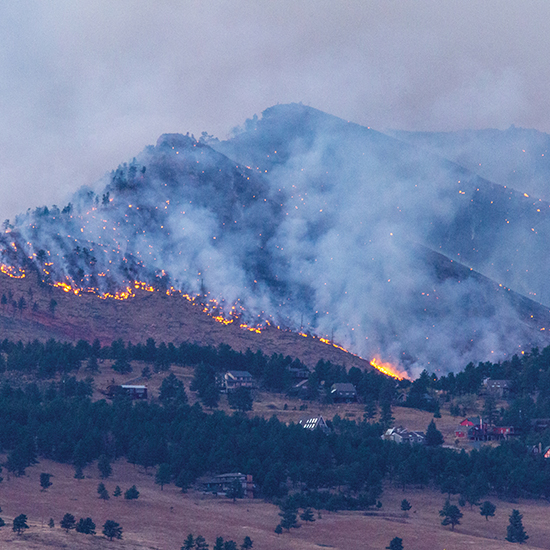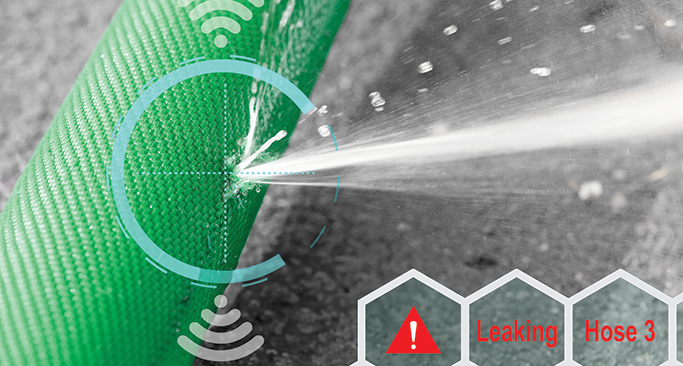Helping property owners improve their
risk profile with new tech and strategies
By Maura Ciccarelli
Protection from natural disasters and everyday emergencies like water leaks and electrical fires have always been top of mind for property owners. However, new technology and strategies now enable agents and brokers to help clients in both high-net-worth and mass markets assess and manage their risk profiles.
“The role of every homeowner has to change,” says Diane Delaney, executive director of the Private Risk Management Association (PRMA), a nonprofit educational trade organization focused on the high-net-worth insurance segment. “They have to start being more proactive [and] smarter in how they’re protecting their homes from smaller claims to these weather-related claims.”
While agents and brokers can’t be experts in every risk area, they can be part of the risk-reduction revolution. They can educate clients at all levels of the market about a range of property risks and the new critical technologies and strategies for mitigation and even prevention, she notes.
“Technology is advancing so rapidly that there will be new features hitting the market every year that all homeowners can benefit from, from the middle market to high net worth,” says Delaney.
“Everyone has to do a better job of educating themselves on what these things are and understanding the protective value they can bring to their homes.”
What’s worrying clients
In The Wealth Report published by Chubb for 2023, about half of respondents said they installed a whole house generator, water leak detection sensors, and smoke and heat detectors. About 22% said they implemented wildfire mitigation strategies around their home’s perimeter.
These elements are linked to larger concerns about risk exposure around the country. Seventy-six percent of those surveyed said they were concerned about extreme weather events due to climate change, while 56% worried about water damage from hurricanes and flooding and wind damage from tornadoes and hail. Thirty-one percent cited wildfire as a major concern.
Respondents also fretted about plumbing-related water damage from leaks and burst pipes (54%) and fires caused by electrical faults and other reasons (64%).
Luckily, Delaney says, tech and strategies exist to help with all these areas.
Tech for all: Water leak and electrical fault detectors
The first innovation is a plumber-installed leak detection system, which can automatically shut off the water valve if water runs too long, as may happen when a pipe bursts.
Delaney installed one of these new devices—in her case, a FloLogic sensor system—because she knew her home had a problem with deteriorating pipes. At 3 a.m. during the first month of the COVID shutdown, a leaking pipe burst above the finished basement. Fortunately, the technology, which is controlled and monitored by a smartphone app, automatically shut off the water.
“If I didn’t have FloLogic, that claim in March of 2020 would have been a complete total loss to my home, because the water would have run for three and a half hours undetected, and I would have had to take my kids and my dog to live Lord knows where,” she says.
The result was a $90,000 claim to repair the pipes, walls, ceilings and other damage, which included re-installing hardwood floors and remediating mold growth behind the walls.
“I have heard stories of people having [the leak detectors] installed and then unplugging the system,” Delaney says.
Why? Sudden water shut off can be inconvenient. Plus, some people don’t learn how to use the app to accommodate changes, like a family member’s longer shower time or refilling the pool. Although restarting the water when it’s been automatically shut off is easy and instant through the app, it can still be inconvenient.
There’s also a trend, Delaney says, of some carriers requiring leak detection technology. “It will take a lot of education on the industry’s part to get clients to understand why they need these installed and that there are people to help them make the decisions on the best system to go with,” she explains.
“What I always challenge people to think about is would you rather pay the money to install a leak detection system into your home or would you rather pay your deductible and have a massive claim?”
As for house fires, Delaney says new detectors can identify unusual electrical activity, such as arcing or power surges within wiring or in connections to devices like house fans and sump pumps that could cause wire damage and lead to a fire.
“It basically helps prevent an electrical fire before it starts,” says Delaney. “It plugs into the outlet and has a sensor on it to notify the homeowner through an app that something is happening.”
One product called Ting has a remote fire safety team that responds to system alerts and works with the homeowners to plan mitigation action. Some insurance carriers will pay for the device and the accompanying annual support subscription.

“The role of every homeowner has to change. They have to start being more proactive [and] smarter in how they’re protecting their homes from smaller claims to these weather-related claims.”
—Diane Delaney
Executive Director
Private Risk Management Association
Innovations in wildfire protection
Agents and brokers can have a role in educating clients at any level to make simple changes to improve their wildfire-risk profile, says Delaney.
Wildfire-resistant landscaping is already a state and insurance requirement for property owners in areas prone to such disasters. Strategies include clearing a five-foot perimeter around a home or structure of combustible elements like trees, bushes, woody mulch, fallen leaves and tree needles, trellises and more, and replacing them with stone, brick and other non-combustible pathways.
Additional steps for protecting homes include ember-resistant vents and gutter guards and re-roofing with noncombustible materials made of wind- and fire-resistant composite tile.
Delaney noted that some communities have joined together to develop and implement plans that earn the area a Firewise USA designation under a program administered by the National Fire Protection Association (NFPA) and co-sponsored by the USDA Forest Service and the National Association of State Foresters.
Breckenridge, Colorado, earned its Firewise status by developing a strategic fire-risk reduction plan and regularly reporting the work residents are doing to protect whole neighborhoods, which includes creating fire breaks and promoting healthier forests.
“It is easier for them to get insurance because they are following these wildfire guidelines,” Delaney says.
Some high-net-worth homeowners, who often may be located in areas like California and other western states where wildfires are more common, have gone beyond landscaping.
Delaney says that when wildfire embers are flying, one system can coat the entire home with fire-resistant foam and set off sprinklers around the property to prevent ignition.
Some high-net-worth clients have gone above and beyond to make their property safe and insurable. One installed an 800,000-gallon water tower, trained as a volunteer fireman to protect his property, uses goats and cows to graze down brush, and institutes controlled burns at appropriate times to reduce the vegetation.
Another client purchased fire trucks to keep on his property and put retired firefighters on retainer to be ready to act. Yet another installed water cannons on top of his canyon property to drench the brush on the slope in the event of a wildfire.
“We need to educate ourselves about … emerging solutions so we can better protect all homeowners.”
—Diane Delaney

For high-net-worth homeowners whose areas are not covered by standard insurance plans, Delaney says non-admitted coverage through E&S policies may be the only option.
“It may cost twice as much as their prior coverage and may not have the same bells and whistles, such as covering alternate housing or replacing expensive components and materials in the home, but at least homeowners will have coverage should a wildfire or other natural disasters strike,” she says.
Hurricane exposures
Agents and brokers also can recommend that homeowners have experts perform an on-site inspection to know if their homes are properly protected against hurricanes.
One client thought his home was fully protected, but it wasn’t. There were openings in the garage that didn’t feature any storm shutter protection, which helps prevent wind uplift of the roof. The builder agreed that the area needed to be upgraded and the client worked on getting the situation remedied.
While storm shutters, roof straps and floodwater venting at the bases of homes have helped homeowners in hurricane-prone areas, roof ages have come under more scrutiny in recent times, Delaney says.
“It used to be that people would have their roof for 30 years, and now you’re hearing 10 to 15 years max when insurance companies want to see them replaced.”
Proactive risk reduction
Delaney says the range of available technology and strategies is only going to grow and brokers and agents have a duty to keep up with innovations.
“In Montana right now, we’re seeing thermal technology cameras being installed in homes for early detection of approaching wildfires,” she says. “Not many people are aware of things like that, but that’s where technology is working in our favor.
“We need to educate ourselves about these emerging solutions so we can better protect all homeowners,” Delaney concludes.
The author
Maura C. Ciccarelli is a longtime freelance journalist originally from Philadelphia. She writes about business and more from an adobe home in southern New Mexico, after spending nine years living on the road full time with her husband in their Airstream trailer.






